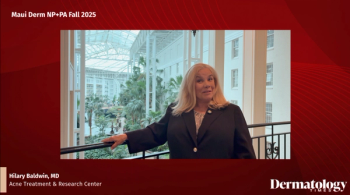
- Dermatology Times, July 2020 (Vol. 41, No. 7)
- Volume 41
- Issue 7
An examination of rosacea treatment satisfaction
A recent study examined the patient-reported side effects and tolerability concerns associated with azelaic acid foam and metronidazole cream and gel preparations.
There are several different treatment options currently used for rosacea; however, sometimes the associated side effects can lead to patient compliance issues and suboptimal outcomes. Azelaic acid 15% foam and metronidazole in cream or gel form are a few popular preparations often used to treat patients with mild-to-moderate rosacea.
A recent study published in the Journal of Drugs in Dermatology1 comparing the agents found that patients treated with the azelaic acid foam preparation reported fewer concerns regarding side effects and tolerability compared with patients treated with metronidazole cream or gel preparations, shedding light on the importance of treatment choices and their impact on clinical outcomes.
Occurring in approximately 10% of adults, rosacea is a chronic inflammatory disease characterized by repeated remissions and exacerbations that can often be challenging to treat. Rosacea is further divided into erythematotelangiectatic, papulopustular, rhinophymatous and ocular subtypes, and depending on the presenting symptoms and their severity, treatments range from oral antibiotics and isotretinoin to topical preparations including brimonidine, oxymetazoline, azelaic acid, metronidazole, and ivermectin.
Azelaic acid foam and metronidazole cream or gel are commonly prescribed preparations in rosacea treatment; however, their use is sometimes limited by the associated side effects including local stinging and burning, pruritus, as well as dryness and erythema. These can often lead to discontinuation of treatment and a prolongation of symptoms and patient suffering.
Researchers examined the differences in patient-reported treatment side effects and concerns associated with azelaic acid foam (AAF) versus metronidazole cream (MC) and metronidazole gel (MG). Using matching-adjusted indirect comparison (MAIC) to compare patient-reported outcomes from survey data evaluating rosacea treatments, the researchers assessed the percentages of patients reporting concerns and side effects and measures of importance of the concerns and the tolerability of the side effects.
Results showed that more MG-treated patients reported treatment concerns compared with those who received AAF therapy (78% vs 16%). When compared with those patients who received AAF therapy, data showed that the MG-treated patients more frequently reported concerns regarding treatment efficacy (54% vs 4%), application (7% vs 3%), and treatment side effects; the MC-treated patients more frequently reported concerns regarding treatment efficacy (61% vs 5%) and dryness (8% vs 5%).
The researchers also found that the patients who received treatment with AAF more frequently reported concerns over the cost of treatment compared with those patients who received MG (7% vs 1%) and those who received MC (9% vs 4%). Results also showed that the level of importance associated with the concerns reported by patients was similar for all treatment groups. On the reported side effects, data indicated that patients receiving MG and MC therapy were less tolerant when compared to those patients receiving AAF therapy.
“Patients treated with AAF are less likely to report concerns with treatment efficacy and report similar or greater tolerance of treatment side effects as patients treated with MG or MC, suggesting that AAF is both an efficacious and tolerable option for the treatment of rosacea,” the authors write.
According to the study authors, the topical rosacea treatment landscape is lacking data from head-to-head trials or real-world studies on benefits and risks. The current study findings suggest that AAF may have a better side effect profile and fewer treatment concerns compared to either MC or MG, which according to the study authors, are important in terms of adherence and symptom control.
Disclosures:
This study was funded by Bayer HealthCare Pharmaceuticals.
Reference:
1 Williamson T, LaRose A, Cameron J, Lott J, Eaddy M, Hopson S, Huai-Che S, Tennant L. Rosacea treatment satisfaction: matching adjusted indirect treatment comparison analysis of metronidazole gel or cream vs azelaic acid foam. J Drugs Dermatol. 2020;19(3): 295-304.
Articles in this issue
over 5 years ago
Injection technique aims to optimize outcomesover 5 years ago
COVID-19: Counseling patients on biologic useover 5 years ago
COVID-19 impact in patients on biologicsover 5 years ago
Immunotherapy implications for NMSCover 5 years ago
Study evaluates topical plus device for rosacea treatmentover 5 years ago
Apremilast treatment in a patient with COVID-19over 5 years ago
IL-17 inhibition a path of interest in rosacea treatmentover 5 years ago
Acne topical efficacy mixedover 5 years ago
Patient appearance challengesover 5 years ago
Physical sunscreens sidestep concernsNewsletter
Like what you’re reading? Subscribe to Dermatology Times for weekly updates on therapies, innovations, and real-world practice tips.

















